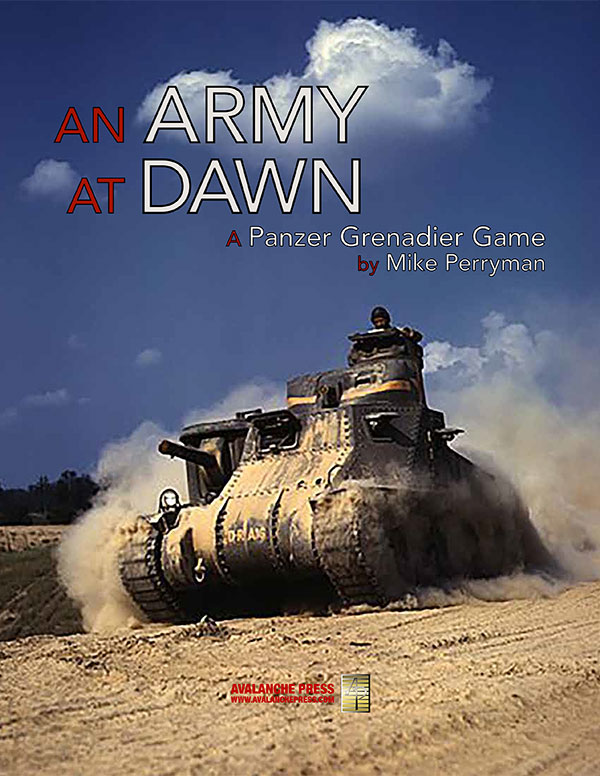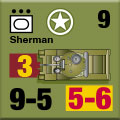| An Army at Dawn
Scenario Preview, Part Six
By Mike Bennighof, Ph.D.
July 2024
 Panzer Grenadier, the game system, takes place at the level of battalion, regimental and brigade commanders. The units are platoon, cavalry squadrons and artillery batteries, but the players represent field-grade officers rather than platoon or (usually) company commanders, or the generals who get their names in the newspaper. Panzer Grenadier, the game system, takes place at the level of battalion, regimental and brigade commanders. The units are platoon, cavalry squadrons and artillery batteries, but the players represent field-grade officers rather than platoon or (usually) company commanders, or the generals who get their names in the newspaper.
Panzer Grenadier: An Army at Dawn shows the U.S. Army undergoing intense growing pains, many of them unnecessary, self-inflicted errors. The worst performances of the American forces fighting in Tunisia, by far, lay in the ranks of the U.S. Army’s general officers. The qualities that had led to their selection did not translate in many cases to the battlefield.
In terms of game play, that means that while players are not saddled with special rules restrictions forcing them to act in the idiotic manner of Lloyd Fredendall, they do inherit situations that at times hand the American side unenviable positions or missions. Let’s have a look at some of those.
Chapter Seven
Combat Command D
 Seemingly unable to command his corps according to its organizational chart, pre-war training, or any other form of logic, II Corps commander Lloyd Fredendall cobbled together a task force he labelled “Combat Command D” for operations in and around Sened Station. The new “Combat Command” included 1st Armored Division’s recon battalion, some troops from 34th Infantry Division’s 168th Infantry Regiment, and some smaller units from both divisions. Fredendall first tapped Col. Robert V. Maraist, commanding the 1st Armored Division’s artillery, to lead the new force. Soon enough, Fredendall became enraged at Maraist’s lack of progress and gave the command to Brig. Gen. Ray E. Porter, assistant division commander of the 34th Infantry Division. Seemingly unable to command his corps according to its organizational chart, pre-war training, or any other form of logic, II Corps commander Lloyd Fredendall cobbled together a task force he labelled “Combat Command D” for operations in and around Sened Station. The new “Combat Command” included 1st Armored Division’s recon battalion, some troops from 34th Infantry Division’s 168th Infantry Regiment, and some smaller units from both divisions. Fredendall first tapped Col. Robert V. Maraist, commanding the 1st Armored Division’s artillery, to lead the new force. Soon enough, Fredendall became enraged at Maraist’s lack of progress and gave the command to Brig. Gen. Ray E. Porter, assistant division commander of the 34th Infantry Division.
Combat Command D didn’t last long, and not surprisingly, was not very successful. It had no reason to exist, other than to allow Fredendall to bypass two division commanders and move their subordinate units across his situation map himself. This only made sense in his specially-constructed command bunker hacked deep into the Tunisian rock. The senior officers located above-ground could only try helplessly to interpret his gibberish-infused orders and watch their men die needless deaths.
Scenario Twenty
Return to Sened Station
1 February 1943
 The American raid on Sened Station had inconvenienced the Axis position in northern Tunisia, but II Corps commander Lloyd Fredendall considered it a great victory and sought to repeat its results. Even now, with the Germans threatening to drive his corps out of the Eastern Dorsals, he only seemed concerned about launching another attack on Maknassy. The first phase of the operation called for his forces to return to the scene of the previous week’s success. The American raid on Sened Station had inconvenienced the Axis position in northern Tunisia, but II Corps commander Lloyd Fredendall considered it a great victory and sought to repeat its results. Even now, with the Germans threatening to drive his corps out of the Eastern Dorsals, he only seemed concerned about launching another attack on Maknassy. The first phase of the operation called for his forces to return to the scene of the previous week’s success.
Conclusion
“It is of vital necessity for you to get forward and place your infantry on its objective four miles east of Sened Station,” Fredendall raged at Col. Robert V. Maraist, commanding Combat Command D. “Too much time has been wasted already.” In the same orders, he fired Maraist, telling him that he would be relieved by Brig. Gen. Ray Porter.
Even as the commanders on the spot tried to translate Fredendall’s gibberish and prepare an attack, Eisenhower himself had taken a hand, directing that 1st Armored Division be used as a complete formation to hold the front and not be split into tiny packets. Combat Command D continued the attack on Sened Station, taking it once, getting ejected by the Italians, and then taking it again. And somehow, Lloyd Fredendall retained his command.
Notes
The Americans are on the attack with a fairly large force on a relatively small battlefield, against Italian defenders well-supplied with support weapons and boasting a company of tough Bersaglieri probably best held back to counter-attack the Americans as the historical commander chose to do.
Scenario Twenty-One
Clearing the Ridge
2 February 1943
 Eisenhower allowed one more attack at Maknassy; if it failed, 1st Armored Division was to pull back and concentrate. Fredendall pushed Combat Command D to capture the ridge line four miles to the east of Sened Station before Ike’s deadline expired. If they failed, all of Fredendall’s successes, as he saw them, would have been for nothing. Eisenhower allowed one more attack at Maknassy; if it failed, 1st Armored Division was to pull back and concentrate. Fredendall pushed Combat Command D to capture the ridge line four miles to the east of Sened Station before Ike’s deadline expired. If they failed, all of Fredendall’s successes, as he saw them, would have been for nothing.
Conclusion
By noon, the Americans had secured the ridge and set up a conventional defense, with the infantry dug in on the high ground, the armor behind it in reserve, and the recon battalion on the flanks. For once moving quickly, the Americans managed to secure their objective before the inevitable counter-attack began.
Notes
This is a new scenario for this edition of An Army at Dawn, a small one featuring an American combined-arms attack against a prepared Italian defense, but neither side is really happy to be here. The Americans have numbers and firepower on their side, and they’re going to need them, as their bar of victory is quite high.
Scenario Twenty-Two
Counterattack at Sened Station
2 February 1943
 The American commanders understood that the Axis would promptly counter-attack their newly-seized positions east of Sened Station, and urged their troops to prepare as quickly as possible. The Germans struck in the afternoon, following an intense bombardment by two dozen Stuka dive bombers. That left the defenders already shaken when German tanks appeared. The American commanders understood that the Axis would promptly counter-attack their newly-seized positions east of Sened Station, and urged their troops to prepare as quickly as possible. The Germans struck in the afternoon, following an intense bombardment by two dozen Stuka dive bombers. That left the defenders already shaken when German tanks appeared.
Conclusion
On seeing enemy tanks for the first time some of the Americans panicked, and the road west became jammed with fleeing vehicles. Others held strong, preventing a catastrophe. Five German tanks broke through and headed west to spread mayhem until confronted by American armor held in reserve. By 1900 the fighting quieted down for the night. When the Americans pulled back the following day, the casualties for their pointless drive on Maknassy totaled 51 killed, 164 wounded, and 116 missing.
Notes
The Americans face a strong German tank-infantry force and are subject to “tank panic” as a result. This one’s going to be tough for the Americans, who have improved a little from previous battles but are slightly outnumbered and slightly outgunned as they try to hold off the Germans. Plus, they face a high-density air attack to open the game.
And that’s it for Chapter Seven. Next time, we dive into Chapter Eight.
You can order An Army at Dawn right here.
Big Red Package
An Army at Dawn
Big Red One
Retail Price: $92.98
Package Price: $85
Gold Club Price: $68
You can order the Big Red Package right here.
Sign up for our newsletter right here. Your info will never be sold or transferred; we'll just use it to update you on new games and new offers.
Mike Bennighof is president of Avalanche Press and holds a doctorate in history from Emory University. A Fulbright Scholar and NASA Journalist in Space finalist, he has published a great many books, games and articles on historical subjects; people are saying that some of them are actually good.
He lives in Birmingham, Alabama with his wife, three children, and new puppy. He misses his lizard-hunting Iron Dog, Leopold.
Want to keep Daily Content free of third-party ads? You can send us some love (and cash) through this link right here.
|
